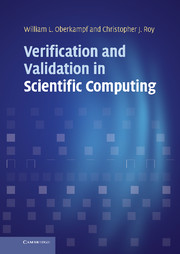Part II - Code verification
Published online by Cambridge University Press: 05 March 2013
Summary
As we begin to address issues of validation in Part IV: Model validation and prediction (Chapters 10–13), the focus will be on whether the proper mathematical model has been chosen, where mathematical model refers to the governing partial differential or integral equations along with any auxiliary algebraic relations. Since the exact solutions to complex mathematical models are extremely rare, we generally use numerical solutions to the discretized equations as a surrogate for the exact solutions. Verification provides a framework for quantifying the numerical approximation errors in the discrete solution relative to the exact solution to the mathematical model. Since verification deals purely with issues of mathematics, no references to the actual behavior of real-world systems or experimental data will be found in Chapters 4 through 9.
Code verification ensures that the computer program (alternatively referred to as the computer code) is a faithful representation of the original mathematical model. It is accomplished by employing appropriate software engineering practices (Chapter 4), and by using order verification (Chapter 5) to ensure that there are no mistakes in the computer code or inconsistencies in the discrete algorithm. This part of the book dealing with code verification is completed by a discussion of exact solutions to mathematical models in Chapter 6. A key part of Chapter 6 is the Method of Manufactured Solutions (MMS), which is a powerful method for performing order verification studies on complex, nonlinear, coupled sets of partial differential or integral equations.
- Type
- Chapter
- Information
- Publisher: Cambridge University PressPrint publication year: 2010



